Sumathi Ramaswamy's Research and Mother India
The content for this portion of the exhibit comes from Ramaswamy’s article “Maps and Mother Goddesses in Modern India,” Imago Mundi, v. 53 (2001), p. 97-114, and book, The Goddess and the Nation: Mapping Mother India. Durham and London: Duke University Press, 2010.
"J. B. Harley notes that 'maps as an impersonal type of knowledge tend to ‘desocialize’ the territory they represent; they foster the notion of a socially empty space'. Focusing on twentieth-century India, this paper considers an alternate tradition of mapping territory in which the nation is cartographically presented to its subject-citizens not as 'empty social space', but as 'Mother India', the Indian nation imagined as woman, mother, goddess. Through an analysis of such 'bodyscapes' of Mother India, I ask what is at stake in cartographically deploying the female body to map national territory. And I consider how such bodyscapes, even as they systematize a particular visual image of 'India', also consolidate the notion of the nation as motherland." (p.97)
"In striking contrast to the scientific map, the bodyscapes I discuss here are not dehumanized, cold or socially empty. On the contrary, they insert into the impersonal geographical space of 'India' the image of an apparently familiar mother-goddess. As such, these maps--and I insist that these bodyscapes are maps--transform abstract territory into lived nation. Moreover, they personalize the nation-space and present it as an entity worth dying for, to remember Tagore's lines.
"Harley has also suggested that because everywhere in the modern world the state has been the 'principal patron of cartographic activity . . . maps are pre-eminently a language of power, not of protest.' Yet these Indian bodyscapes are not the work of the state but of individual citizen-subjects, patriotic organizations and political parties. While we may not necessarily see them as articulating a language of protest, they none the less challenge normative state-sponsored cartographical representations of 'India'. As such, they are expressions of a cartographical practice that prevails outside the purview of the modern state, colonial as well as post-colonial, although they do appropriate some of the latter's protocols and forms." (p.98)
Dr. Ramaswamy is Professor of History at Duke University and Director of the Duke Center for South Asian Studies. She is a cultural historian of South Asia and the British empire. Her research interests include visual studies, the history of cartography, and gender.
Mapping Mother India
The content for this page of the exhibit are from Sumathi Ramaswamy's book The Goddess and The Nation: Mapping Mother India.
The image of Mother India, or as named in various Indian languages Bharat Mata, appeared near the end of the nineteenth century as a novel deity of the nation and country. Over time this goddess was “imagined as the substantial embodiment of national territory - its inviolable essence, its shining beacon of hope and liberation - and also as a powerful rallying symbol in its long hard struggle for independence in the modern world’s largest empire” (pg. 1). During India’s transformation from Britain’s most important colony to the free states of India and Pakistan, Mother India became a symbol common to celebration and devotion to the “region’s vast population fissured by caste, language, ethnicity, and local and regional sentiments even as she came to be perceived as the escalating the irrevocable rupture catastrophically developing between its two dominant religious communities, Hindu and Muslim” (pg. 2).

Al-Idrisi to Ptolemy: Early Maps of India

About This Exhibit


